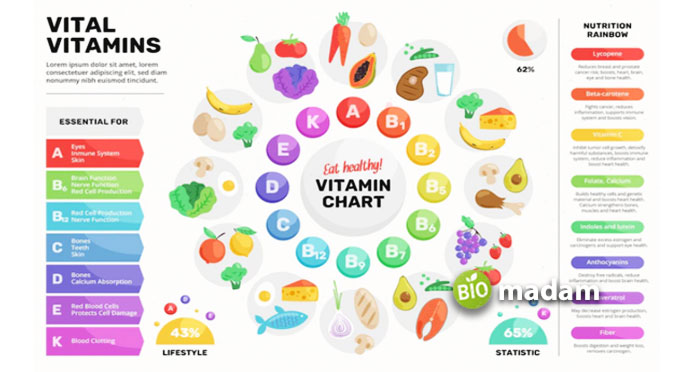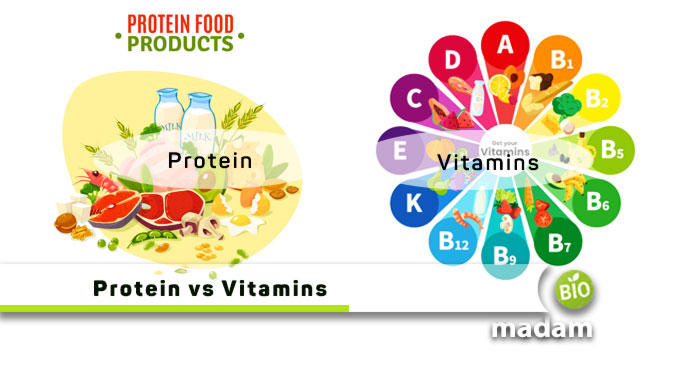Our body utilizes various micronutrients and macronutrients to carry out vital processes. These processes may include cellular-level activities or processes involved in development and movement. Proteins and vitamins are important parts of the daily nutrient intake for normal body functioning. They contribute to adequate physical and mental growth of humans. Let’s discuss the differences between proteins and vitamins in detail today.
Comparison Table
| Characteristics | Proteins | Vitamins |
| Function | Body muscle production and repair | Energy processing |
| Types | Globular & fibrous | Fat & water soluble |
| Synthesis | Inside the body | External sources |
| Building Unit | Amino acids | Vitamers |
| Molecular Size | 20,000 – 30,000 Da | Few hundred Da |
| Requirements | Large amount | Small amount |
| Sources | Beans, tofu, soy, eggs, lean meat | Citrus fruits, milk, sea food, potatoes |
What are Proteins?
Lipids, carbohydrates and proteins are all types of macronutrients. Like other macronutrients, proteins are also required in higher amounts in the body.
NCI defines proteins as molecules made of amino acids.
Proteins are polypeptides formed by the combination of different amino acids. There are 20 amino acids that join together to produce various protein compounds. Proteins are large molecules with subunits of 20,000 to 30,000 Da.

Structure of Proteins
As mentioned earlier, all proteins are made up of 20 different amino acids coming together to form enormous molecules. The basic protein structure comprises polypeptide chains of amino acids linked together by peptide bonds. The polypeptide chains form a 3-D shape consisting multiple loops, folds and curves depending on the level of protein structure. Protein structures may be of four types. These are primary, secondary, tertiary, and quaternary. The chemical bonds including ionic, covalent, and metallic bonds also contribute to determination of protein structure type.
Function of Proteins
Different types of proteins have unique functions in the body. Antibodies, antigens, blood cells, hormones, and enzymes are all proteins involved in particular activities. The proteins in the body also contribute to muscle mass, enabling us to move our body parts.
Protein synthesis requires amino acids, out of which, some cannot be synthesized by the body. Thus, these essential amino acids must be taken in required amounts to ensure proper development and movement. Proteins are specifically important during the period of growth and increased demand such as pregnancy and breastfeeding.
Types of Proteins
The different types of proteins may be categorized into various groups according to structural or functional characteristics. The most widely studied classification of proteins includes fibrous and globular proteins on the basis of their structure.
Fibrous Proteins: As the name indicates, fibrous proteins are long and thin in the form of fibers and wires. Collagen and keratin are fibrous proteins that contribute to the formation and maintenance of skin and hair.
Globular Proteins: On the other hand, globular proteins are spherical and make up molecules like immunoglobulins, hemoglobin and myoglobin. They help the transport of oxygen throughout the body and protect your body by building several types of immunity.
Dietary Requirements
An average sedentary adult should consume adequate macro and micronutrients, including carbs, proteins, vitamins, minerals, etc. An adult is recommended to take 0.8 grams of protein per kilogram of their weight. However, people who perform strenuous activities, majorly athletes, should take 1.6 gram of protein per kg of their weight.
Animal based foods like meat, dairy, poultry, fish and eggs are plentiful in protein. Moreover, seeds, grains, nuts, tofu and soya are plant-based proteins. Click here to go through some quick ways to consume an egg.
What are Vitamins?
Like macronutrients, micronutrients are also essential for normal body functioning. Vitamins and minerals are micronutrients that our body requires in recommended amounts to carry our bodily functions.
Vitamins are defined as organic carbon compounds that your body does not produce. Hence, you have to take vitamins per dietician’s recommendation.

Structure of Vitamins
Vitamins are produced by living organisms including plants, animals, and fungi. Different types of vitamins have specific structures comprising groups of related molecules known as vitamers. For example, Vitamin E has eight vitamers, four out of which are tocopherols and four are tocotrienols.
Functions of Vitamins
Vitamins majorly contribute to managing and regulating normal body functions like growth and development. They contribute to cellular processes that liberate energy to carry out body processes. Different vitamins perform specific functions like maintaining bone health, improving eyesight and producing blood clotting factors.
Types of Vitamins
There are thirteen vitamins known to researchers so far. They include Vitamin A, Vitamin B complex (eight B vitamins), Vitamin C, Vitamin D, Vitamin E, and Vitamin K. They are categorized as water soluble and fat-soluble vitamins.
- Fat-soluble Vitamins: Fat-soluble vitamins do not dissolve in aqueous mediums and only dissolve in fats and oils. They are absorbed in the small intestine and stored in the liver and body’s fat tissues. Fat-soluble vitamins include vitamins A, D, E, and K.
- Water-soluble Vitamins: Water-soluble vitamins dissolve in water readily and absorb into the tissues immediately. They are required more in the body as they get consumed immediately. Vitamin B complex (B1, B2, B3, B4, B6, B7, B9 and B12) and Vitamin C are water-soluble vitamins.
Dietary Requirements
The dietary requirement for each vitamin is different depending on its role and function in the body. Water soluble vitamins are required in higher amounts with the highest 75 mg daily requirement of vitamin C. At the same time fat-soluble vitamins are required up to 10 grams in your diet.
You can obtain vitamins from different plant and animal sources. Some simple sources of vitamins include citrus fruits, milk, yogurt, bananas, carrots, and beef. The good part is, yogurt intake helps in relieving constipation as well.
Differences Between Proteins and Vitamins
Definition
Proteins
Proteins are large macromolecules required by the body in large amounts for growth and development.
Vitamins
Vitamins, on the contrary, are micronutrients and participate in various biological processes in the body.
Function
Proteins
Different types of proteins perform different functions including building and repairing body tissues besides metabolic reactions.
Vitamins
Whereas vitamins are essential for the processing of energy in living cells to carry out vital body functions.
Types
Proteins
Proteins are primarily of two types on the basis of their structure, i.e., globular and fibrous proteins for specific functions. Other types include types of antibodies, hormones, contractile proteins, storage proteins, and transport proteins.
Vitamins
At the same time, there are 13 vitamins essential to living organisms. They are categorized into water soluble and fat soluble vitamins. Vitamin B complex and Vitamin C are water soluble. Vitamin A, D, E, and K are fat soluble.
Synthesis
Proteins
Proteins are synthesized by the body from scratch using amino acids or by modifying other molecules in the body.
Vitamins
In contrast, your body cannot synthesize vitamins on its own. Therefore, it is important to take vitamins from different food sources.
Building Units
Proteins
The building units of proteins are called amino acids that join together to form polypeptide chains that build proteins.
Vitamins
Alternatively, vitamins comprise multiple subunits called vitamers that make the structure of vitamins.
Molecular size
Proteins
Proteins are macromolecules and large in size. They weigh 20,000 to 30,000 Da on average.
Vitamins
Conversely, vitamins are smaller molecules and weigh only a few hundred Da.
Requirement
Proteins
Proteins are macronutrients which means that they are required in large amounts by the body for optimum performance.
Vitamins
However, vitamins are micronutrients and required in small amounts to facilitate bodily functions.
Required Amount
Proteins
An average sedentary adult must take 0.8 grams of protein per kilogram of their weight.
Vitamins
Yet, the daily recommended nutritional value for each vitamin differs varying from micrograms to a few grams.
Source
Proteins
Lean meat, beans, tofu, and soy are surplus sources of proteins.
Vitamins
While you can obtain vitamins from dragon fruit, oranges, milk, and seafood.
The Bottom Line
Proteins and vitamins play a major role in maintaining the human anatomy and physiology through muscle mass and energy processing. Proteins contribute to the formation of hormones, antigens, enzymes, red blood cells and white blood cells. They also make up skin and hair. Vitamins regulate hormones and support bone maintenance. The main difference between proteins and vitamins is their daily requirement. Despite the difference in their exact function, they are essential for normal body functioning.
FAQs
How are proteins and vitamins related?
Proteins and vitamins are critical elements of a healthy body. Proteins are one of the macromolecules in the body, whereas vitamins are micromolecules. B vitamins, including niacin, cobalamin, thiamin, and riboflavin, are found in protein.
Is protein a nutrient or vitamin?
Protein and vitamins are both nutrients in the body. Proteins are one of the three macromolecules besides fats and carbohydrates. They are involved in growing and repairing cells.
Is vitamin A a nutrient or not?
Vitamin A and other vitamins are micronutrients like minerals. You need to intake an essential micronutrient as your body cannot make minerals.

Meet me; I am Paulina Zaniewska, who’s more hooked on providing the best health blog. I’ve always been so determined to compete as a nutritionist, and here I am, done with a Master’s in food technology. My brilliant performance throughout encouraged me to help people.

